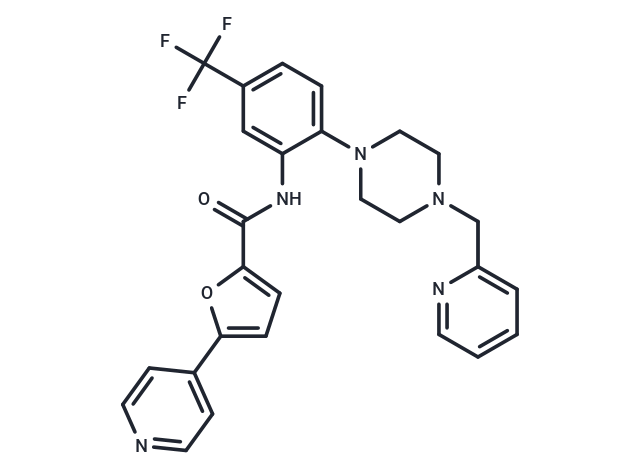Shopping Cart
- Remove All
 Your shopping cart is currently empty
Your shopping cart is currently empty

SPHINX31 is a potent inhibitor of serine/arginine-rich protein kinase 1 (SRPK1; IC50: 5.9 nM).

| Pack Size | Price | Availability | Quantity |
|---|---|---|---|
| 1 mg | $34 | In Stock | |
| 5 mg | $76 | In Stock | |
| 10 mg | $98 | In Stock | |
| 25 mg | $189 | In Stock | |
| 50 mg | $283 | In Stock | |
| 100 mg | $453 | In Stock | |
| 500 mg | $1,050 | In Stock | |
| 1 mL x 10 mM (in DMSO) | $89 | In Stock |
| Description | SPHINX31 is a potent inhibitor of serine/arginine-rich protein kinase 1 (SRPK1; IC50: 5.9 nM). |
| Targets&IC50 | SRPK1:5.9 nM (cell free) |
| In vitro | SPHINX31 inhibits phosphorylation of serine/arginine-rich splicing factor 1 (SRSF1), an SRPK1 substrate, in PC3 cells (EC50: 360 nM) and increases expression of the anti-angiogenic VEGF-A165b splice variant in retinal pigment epithelial (RPE) cells [1]. SPHINX31 inhibited the growth of MLL-mutant AML cell lines with an IC50? >1 order of magnitude lower than for other AML lines. There was no impact of SPHINX31 on the clonogenic potential of normal mouse hematopoietic stem-progenitor cells (HSPCs). 1.5, 3, and 6?μM SPHINX31 did not affect the colony-forming ability of normal human cord blood CD34+ cells [2]. |
| In vivo | In vivo, SPHINX31 (2 μg per eye) inhibits blood vessel growth and macrophage infiltration in the eyes of a mouse model of choroidal neovascularization [1]. Injection of 0.8?mg/kg SPHINX31 (i.p.) into DBA2J mice resulted in a concentration of 0.225?±?0.036?μM in plasma after 24?h. In xenotransplanted RAIL mice with MOLM-13, THP-1 cells or first passage patient-derived AMLs, SPHINX31 (0.8 or 2.0 mg/kg) led to a significant reduction in leukemic cell growth and a dose-dependent prolongation of survival of mice given MOLM-13, THP-1, and patient-derived MLL-X AMLs [2]. |
| Cell Research | Cells were transduced with gRNA vectors or treated with SPHINX31 and stained at the indicated time points with anti-mouse CD11b PE/Cy5 and anti-human CD11b PE or anti-human CD13 FITC. Data were analyzed by using LSRFortessa and FlowJo. Apoptosis levels were measured in human and/or mouse AML cells transduced with dual gRNA vectors (against SRPK1 and 3' BCL2 enhancer) and/or treated with 1 or 3?μM SPHINX31 at indicated time points, by using Annexin V. Data were analyzed by using LSRFortessa instruments. Cell cycle stages were measured in human and/or mouse AML cells transduced with dual gRNA vectors against SRPK1 and/or treated with 1 or 3?μM SPHINX31 at indicated time points, using Propidium Iodide. Data were analyzed using LSRFortessa instruments [2]. |
| Animal Research | For in vivo experiments, 6–10-week-old female Rosa26Cas9/+ mice were treated triweekly for two weeks with either vehicle or 2?mg/kg SPHINX31. Four weeks post-treatment, bone marrow cells from these mice were freshly extracted (as mentioned above) and blocked with anti-mouse CD16/32 and 10% mouse serum. For the identification of LK/LSK, LT-HSC, myeloid and B-cell subpopulations, staining was performed using CD4 PE/Cy5, CD5 PE/Cy5, CD8a PE/Cy5, CD11b PE/Cy5, B220 PE/Cy5, TER-119 PE/Cy5, GR-1 PE/Cy5, SCA-1 Pacific Blue, CD150 PE/Cy7, CD34 FITC and CD117 APC-eFluor780. In each of the multi-colour flow cytometry experiments, we included the fluorescence minus one (FMO) controls. FMO controls provide a measure of spillover in a given channel. This allows for correct gating and selects only the stained cells in the experimental sample. Flow cytometry analysis was performed using a LSRFortessa instrument and resulting data were subsequently analyzed using FlowJo [2]. |
| Molecular Weight | 507.51 |
| Formula | C27H24F3N5O2 |
| Cas No. | 1818389-84-2 |
| Smiles | FC(F)(F)c1ccc(N2CCN(Cc3ccccn3)CC2)c(NC(=O)c2ccc(o2)-c2ccncc2)c1 |
| Relative Density. | 1.342 g/cm3 (Predicted) |
| Storage | Powder: -20°C for 3 years | In solvent: -80°C for 1 year | Shipping with blue ice. | ||||||||||||||||||||
| Solubility Information | Ethanol: 10 mg/mL (19.7 mM), Sonication is recommended. H2O: Insoluble DMSO: 5.08 mg/mL (10.01 mM), Sonication is recommended. | ||||||||||||||||||||
Solution Preparation Table | |||||||||||||||||||||
DMSO/Ethanol
| |||||||||||||||||||||

Copyright © 2015-2025 TargetMol Chemicals Inc. All Rights Reserved.